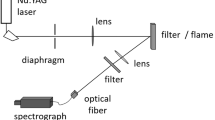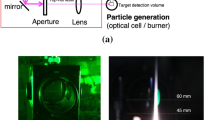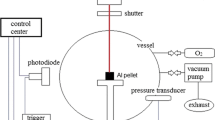Abstract
The development of laser-induced incandescence (LII) approach for characterizing the production of high-purity non-carbonaceous metal oxides produced in flame synthesis systems is in progress. This work aims to prove the feasibility of LII measurement for titanium dioxide (TiO\(_2\)). In previous works, laser-induced emission (LIE) was investigated for flame-synthetized TiO\(_2\) particles. However, the presence of carbon materials was detected. As this calls into question the nature of the signal, we consider in this work LIE of high-purity engineered TiO\(_2\) nanoparticles to circumvent the carbon issue. Specifically, we investigate the spectral and temporal laser-induced emissions of pure TiO\(_2\) nanoparticles dispersed in a non-reactive environment. In parallel, LIE from carbon black is examined to validate the strategy and highlight differences between carbon black and TiO\(_2\). The TiO\(_2\) results indicate that depending on the laser fluence, different prompt interferences appear. The literature suggests that these non-thermal emissions are likely to be from fluorescence or phase-selective laser-induced breakdown spectroscopy, both characterized by a short lifetime. To avoid these parasitic signals, measurement acquisition time is delayed. A spectral red-shift is observed with time as a result of decreasing particle temperature. This proves the LII nature of delayed emission from pure TiO\(_2\), which is confirmed by the LII-like nature of the temporal signals.
















Similar content being viewed by others
Notes
Assuming \(d_{\text {p}}(t)\) to be constant means that sublimation is negligible during the duration of the LII process.
References
F. Meierhofer, U. Fritsching, Synthesis of metal oxide nanoparticles in flame sprays: review on process technology, modeling, and diagnostics. Energy & Fuels 35(7), 5495–5537 (2021)
H.G. Völz, J. Kischkewitz, P. Woditsch, A. Westerhaus, W.-D. Griebler, M. De Liedekerke, G. Buxbaum, H. Printzen, M. Mansmann, D. Räde et al., Pigments, inorganic. Ullmann’s Encyclopedia of Industrial Chemistry (2000)
S. Zahmatkesh, M. Hajiaghaei-Keshteli, A. Bokhari, S. Sundaramurthy, B. Panneerselvam, Y. Rezakhani, Wastewater treatment with nanomaterials for the future: A state-of-the-art review. Environmental Research, 114652 (2022)
X. Hou, K. Aitola, P.D. Lund, TiO\(_{2}\) nanotubes for dye-sensitized solar cells-a review. Energy Science & Engineering 9(7), 921–937 (2021)
P. Roth, Particle synthesis in flames. Proceedings of the combustion institute 31(2), 1773–1788 (2007)
S.E. Pratsinis, Flame aerosol synthesis of ceramic powders. Progress in Energy and Combustion Science 24(3), 197–220 (1998)
M.Y. Manuputty, C.S. Lindberg, J.A. Dreyer, J. Akroyd, J. Edwards, M. Kraft, Understanding the anatase-rutile stability in flame-made TiO\(_{2}\). Combustion and Flame 226, 347–361 (2021)
Y. Ren, K. Ran, S. Kruse, J. Mayer, H. Pitsch, Flame synthesis of carbon metal-oxide nanocomposites in a counterflow burner. Proceedings of the Combustion Institute 38(1), 1269–1277 (2021)
F. Cignoli, C. Bellomunno, S. Maffi, G. Zizak, Laser-induced incandescence of titania nanoparticles synthesized in a flame. Applied Physics B 96(4), 593–599 (2009)
N.K. Memon, D.H. Anjum, S.H. Chung, Multiple-diffusion flame synthesis of pure anatase and carbon-coated titanium dioxide nanoparticles. Combustion and flame 160(9), 1848–1856 (2013)
C. Russo, B. Apicella, A. Tregrossi, A. Ciajolo, K.C. Le, S. Török, P.-E. Bengtsson, Optical band gap analysis of soot and organic carbon in premixed ethylene flames: Comparison of in-situ and ex-situ absorption measurements. Carbon 158, 89–96 (2020)
T.A. Sipkens, J. Menser, T. Dreier, C. Schulz, G.J. Smallwood, K.J. Daun, Laser-induced incandescence for non-soot nanoparticles: recent trends and current challenges. Applied Physics B 128(4), 1–31 (2022)
H.A. Michelsen, Laser-induced incandescence of flame-generated soot on a picosecond time scale. Applied Physics B 83(3), 443–448 (2006)
J. Liqiang, Q. Yichun, W. Baiqi, L. Shudan, J. Baojiang, Y. Libin, F. Wei, F. Honggang, S. Jiazhong, Review of photoluminescence performance of nano-sized semiconductor materials and its relationships with photocatalytic activity. Solar Energy Materials and Solar Cells 90(12), 1773–1787 (2006)
N. Serpone, D. Lawless, R. Khairutdinov, Size effects on the photophysical properties of colloidal anatase TiO\(_{2}\) particles: size quantization versus direct transitions in this indirect semiconductor? The journal of Physical Chemistry 99(45), 16646–16654 (1995)
C.C. Mercado, F.J. Knorr, J.L. McHale, S.M. Usmani, A.S. Ichimura, L.V. Saraf, Location of hole and electron traps on nanocrystalline anatase TiO\(_{2}\). The Journal of Physical Chemistry C 116(19), 10796–10804 (2012)
K. Fujihara, S. Izumi, T. Ohno, M. Matsumura, Time-resolved photoluminescence of particulate TiO\(_{2}\) photocatalysts suspended in aqueous solutions. Journal of Photochemistry and Photobiology A: Chemistry 132(1–2), 99–104 (2000)
J. Shi, J. Chen, Z. Feng, T. Chen, Y. Lian, X. Wang, C. Li, Photoluminescence characteristics of TiO\(_{2}\) and their relationship to the photoassisted reaction of water/methanol mixture. The journal of physical chemistry C 111(2), 693–699 (2007)
D.K. Pallotti, L. Passoni, P. Maddalena, F. Di Fonzo, S. Lettieri, Photoluminescence mechanisms in anatase and rutile TiO\(_{2}\). The Journal of Physical Chemistry C 121(16), 9011–9021 (2017)
J. Zhang, X. Chen, Y. Shen, Y. Li, Z. Hu, J. Chu, Synthesis, surface morphology, and photoluminescence properties of anatase iron-doped titanium dioxide nano-crystalline films. Physical Chemistry Chemical Physics 13(28), 13096–13105 (2011)
P.B. Nair, V. Justinvictor, G.P. Daniel, K. Joy, K.J. Raju, D.D. Kumar, P. Thomas, Optical parameters induced by phase transformation in rf magnetron sputtered TiO\(_{2}\) nanostructured thin films. Progress in Natural Science: Materials International 24(3), 218–225 (2014)
Y. Zhang, S. Li, Y. Ren, Q. Yao, C.K. Law, Two-dimensional imaging of gas-to-particle transition in flames by laser-induced nanoplasmas. Applied Physics Letters 104(2), 023115 (2014)
Y. Zhang, S. Li, Y. Ren, Q. Yao, D.T. Stephen, A new diagnostic for volume fraction measurement of metal-oxide nanoparticles in flames using phase-selective laser-induced breakdown spectroscopy. Proceedings of the Combustion Institute 35(3), 3681–3688 (2015)
Y. Ren, J. Wei, S. Li, In-situ laser diagnostic of nanoparticle formation and transport behavior in flame aerosol deposition. Proceedings of the Combustion Institute 37(1), 935–942 (2019)
Y. Ren, Y. Zhang, S. Li, C.K. Law, Doping mechanism of vanadia/titania nanoparticles in flame synthesis by a novel optical spectroscopy technique. Proceedings of the Combustion Institute 35(2), 2283–2289 (2015)
Y. Ren, Y. Zhang, S. Li, Simultaneous single-shot two-dimensional imaging of nanoparticles and radicals in turbulent reactive flows. Physical Review Applied 13(4), 044002 (2020)
Y. Zhang, G. Xiong, S. Li, Z. Dong, S.G. Buckley, D.T. Stephen, Novel low-intensity phase-selective laser-induced breakdown spectroscopy of TiO\(_{2}\) nanoparticle aerosols during flame synthesis. Combustion and flame 160(3), 725–733 (2013)
G. Xiong, S. Li, D.T. Stephen, Tuning excitation laser wavelength for secondary resonance in low-intensity phase-selective laser-induced breakdown spectroscopy for in-situ analytical measurement of nanoaerosols. Spectrochimica Acta Part B: Atomic Spectroscopy 140, 13–21 (2018)
A.C. Eckbreth, Effects of laser-modulated particulate incandescence on raman scattering diagnostics. Journal of Applied Physics 48(11), 4473–4479 (1977)
S. Will, S. Schraml, A. Leipertz, Two-dimensional soot-particle sizing by time-resolved laser-induced incandescence. Optics letters 20(22), 2342–2344 (1995)
L.A. Melton, Soot diagnostics based on laser heating. Applied optics 23(13), 2201–2208 (1984)
B.F. Kock, C. Kayan, J. Knipping, H.R. Orthner, P. Roth, Comparison of lii and tem sizing during synthesis of iron particle chains. Proceedings of the Combustion Institute 30(1), 1689–1697 (2005)
K. Daun, J. Menser, R. Mansmann, S.T. Moghaddam, T. Dreier, C. Schulz, Spectroscopic models for laser-heated silicon and copper nanoparticles. Journal of Quantitative Spectroscopy and Radiative Transfer 197, 3–11 (2017)
R.L. Vander Wal, T.M. Ticich, J.R. West, Laser-induced incandescence applied to metal nanostructures. Applied optics 38(27), 5867–5879 (1999)
I. Altman, D. Lee, J. Chung, J. Song, M. Choi, Light absorption of silica nanoparticles. Physical Review B 63(16), 161402 (2001)
R. Weeks, W. Duley, Aerosol-particle sizes from light emission during excitation by tea CO\(_{2}\) laser pulses. Journal of Applied physics 45(10), 4661–4662 (1974)
B. Tribalet, A. Faccinetto, T. Dreier, C. Schultz, Evaluation of particle sizes of iron-oxide nano-particles in a low-pressure flame-synthesis reactor by simultaneous application of tire-lii and pms, in 5th Workshop on Laser-induced Incandescence (2012)
A. Eremin, E. Gurentsov, E.Y. Mikheyeva, S. Musikhin, Binary iron–carbon nanoparticle synthesis in photolysis of Fe(CO)\(_{5}\) with methane and acetylene, in Journal of Physics: Conference Series, vol. 774, p. 012127 (2016). IOP Publishing
A. Eremin, E. Gurentsov, S. Musikhin, Synthesis of binary iron-carbon nanoparticles by UV laser photolysis of Fe(CO)\(_{5}\) with various hydrocarbons. Materials Research Express 3(10), 105041 (2016)
S. Maffi, F. Cignoli, C. Bellomunno, S. De Iuliis, G. Zizak, Spectral effects in laser induced incandescence application to flame-made titania nanoparticles. Spectrochimica Acta Part B: Atomic Spectroscopy 63(2), 202–209 (2008)
G. De Falco, M. Commodo, P. Minutolo, A. D’Anna, Flame aerosol synthesis and thermophoretic deposition of superhydrophilic TiO\(_{2}\) nanoparticle coatings. Chemical Engineering Transactions 73, 37–42 (2019)
S. De Iuliis, R. Dondè, I. Altman, Light emission of flame-generated TiO\(_{2}\) nanoparticles: Effect of ir laser irradiation. Journal of Quantitative Spectroscopy and Radiative Transfer 258, 107353 (2021)
H.K. Kammler, S.E. Pratsinis, Carbon-coated titania nanostructured particles: Continuous, one-step flame-synthesis. Journal of materials research 18(11), 2670–2676 (2003)
M. Darmenkulova, M. Aitzhanov, S.A. Zhumatova, M. Ibraimov, Y. Sagidolda, Change of optical properties of carbon-doped silicon nanostructures under the influence of a pulsed electron beam. Journal of Nanotechnology 2022 (2022)
F. Liu, J. Yon, A. Fuentes, P. Lobo, G.J. Smallwood, J.C. Corbin, Review of recent literature on the light absorption properties of black carbon: Refractive index, mass absorption cross section, and absorption function. Aerosol Science and Technology 54(1), 33–51 (2020)
T.C. Williams, C.R. Shaddix, K.A. Jensen, J.M. Suo-Anttila, Measurement of the dimensionless extinction coefficient of soot within laminar diffusion flames. International Journal of Heat and Mass Transfer 50(7–8), 1616–1630 (2007)
Ü.Ö. Köylü, G.M. Faeth, Spectral Extinction Coefficients of Soot Aggregates From Turbulent Diffusion Flames. Journal of Heat Transfer 118(2), 415–421 (1996)
H.-C. Chang, T. Charalampopoulos, Determination of the wavelength dependence of refractive indices of flame soot. Proceedings of the Royal Society of London. Series A: Mathematical and Physical Sciences 430(1880), 577–591 (1990)
D.R. Snelling, F. Liu, G.J. Smallwood, Ö.L. Gülder, Determination of the soot absorption function and thermal accommodation coefficient using low-fluence lii in a laminar coflow ethylene diffusion flame. Combustion and flame 136(1–2), 180–190 (2004)
S. Sarkar, V. Gupta, M. Kumar, J. Schubert, P.T. Probst, J. Joseph, T.A. König, Hybridized guided-mode resonances via colloidal plasmonic self-assembled grating. ACS applied materials & interfaces 11(14), 13752–13760 (2019)
T. Siefke, S. Kroker, K. Pfeiffer, O. Puffky, K. Dietrich, D. Franta, I. Ohlídal, A. Szeghalmi, E.-B. Kley, A. Tünnermann, Materials pushing the application limits of wire grid polarizers further into the deep ultraviolet spectral range. Adv. Opt. Mater. 4(11), 1780–1786 (2016)
H.-Y. Liu, Y.-L. Hsu, H.-Y. Su, R.-C. Huang, F.-Y. Hou, G.-C. Tu, W.-H. Liu, A comparative study of amorphous, anatase, rutile, and mixed phase TiO\(_2\) films by mist chemical vapor deposition and ultraviolet photodetectors applications. IEEE Sens. J. 18(10), 4022–4029 (2018)
G. Jellison Jr., L. Boatner, J. Budai, B.-S. Jeong, D. Norton, Spectroscopic ellipsometry of thin film and bulk anatase (TiO\(_{2}\)). J. Appl. Phys. 93(12), 9537–9541 (2003)
S. De Iuliis, F. Migliorini, R. Dondè, Laser-induced emission of tio 2 nanoparticles in flame spray synthesis. Appl. Phys. B 125(11), 1–11 (2019)
H.A. Michelsen, Understanding and predicting the temporal response of laser-induced incandescence from carbonaceous particles. J. Chem. Phys. 118(15), 7012–7045 (2003)
F. Goulay, P.E. Schrader, L. Nemes, M.A. Dansson, H.A. Michelsen, Photochemical interferences for laser-induced incandescence of flame-generated soot. Proc. Combust. Inst. 32(1), 963–970 (2009)
T. Posch, F. Kerschbaum, D. Fabian, H. Mutschke, J. Dorschner, A. Tamanai, T. Henning, Infrared properties of solid titanium oxides: exploring potential primary dust condensates. Astrophys. J. Suppl. Ser. 149(2), 437 (2003)
M.J. O’Neil, A. Smith, P.E. Heckelman, S. Budavari, The Merck Index—An Encyclopedia of Chemicals, Drugs, and Biologicals. Whitehouse Station (Merck and co. Inc, New Jersey, 2001), p.4342
J.C. Miller, Optical properties of liquid metals at high temperatures. Philos. Mag. 20(168), 1115–1132 (1969)
D.L. Parry, M.Q. Brewster, Optical constants of Al\(_{2}\)O\(_{3}\) smoke in propellant flames. J. Thermophys. Heat Transf. 5(2), 142–149 (1991)
F. Goulay, L. Nemes, P.E. Schrader, H.A. Michelsen, Spontaneous emission from C\(_{2}\) (d\(^{3}{\Pi _{g}}\)) and C\(_{3}\) (A \(^{1}{\Pi _{u}}\)) during laser irradiation of soot particles. Mol. Phys. 108(7–9), 1013–1025 (2010)
Z. Gao, L. Han, J. Li, Investigation of laser induced air breakdown thresholds at 1064, 532, 355, 266 and 248nm, in Pacific Rim Laser Damage 2019: Optical Materials for High-Power Lasers, vol. 11063, pp. 23–27 (2019). SPIE
G. Xiong, S. Li, Y. Zhang, S.G. Buckley, D.T. Stephen, Phase-selective laser-induced breakdown spectroscopy of metal-oxide nanoparticle aerosols with secondary resonant excitation during flame synthesis. J. Anal. At. Spectrom. 31(2), 482–491 (2016)
Y. Ren, S. Li, Y. Zhang, D.T. Stephen, M.B. Long, Absorption-ablation-excitation mechanism of laser-cluster interactions in a nanoaerosol system. Phys. Rev. Lett. 114(9), 093401 (2015)
R.F. LeBouf, A.L. Miller, C. Stipe, J. Brown, N. Murphy, A.B. Stefaniak, Comparison of field portable measurements of ultrafine TiO\(_2\): X-ray fluorescence, laser-induced breakdown spectroscopy, and fourier-transform infrared spectroscopy. Environ. Sci. Process. Imp. 15(6), 1191–1198 (2013)
J. Menneveux, F. Wang, S. Lu, X. Bai, V. Motto-Ros, N. Gilon, Y. Chen, J. Yu, Direct determination of ti content in sunscreens with laser-induced breakdown spectroscopy: Line selection method for high TiO\(_{2}\) nanoparticle concentration. Spectrochim. Acta Part B At. Spectrosc. 109, 9–15 (2015)
R. Noll, Laser-Induced Breakdown Spectroscopy (Springer, Heidelberg, 2012)
S. Bejaoui, S. Batut, E. Therssen, N. Lamoureux, P. Desgroux, F. Liu, Measurements and modeling of laser-induced incandescence of soot at different heights in a flat premixed flame. Appl. Phys. B 118(3), 449–469 (2015)
Y.J. Lee, N.W. Song, S.K. Kim, Photoluminescence of C\(_{60}\) and its photofragments in the gas phase. J. Phys. Chem. A 106(23), 5582–5590 (2002)
E.A. Rohlfing, Optical emission studies of atomic, molecular, and particulate carbon produced from a laser vaporization cluster source. J. Chem. Phys. 89(10), 6103–6112 (1988)
R.L. Vander Wal, G.M. Berger, T.M. Ticich, P.D. Patel, Application of laser-induced incandescence to the detection of carbon nanotubes and carbon nanofibers. Appl. Opt. 41(27), 5678–5690 (2002)
K.K. Paul, P. Giri, Role of surface plasmons and hot electrons on the multi-step photocatalytic decay by defect enriched Ag@ TiO\(_{2}\) nanorods under visible light. J. Phys. Chem. C 121(36), 20016–20030 (2017)
B. Santara, P. Giri, K. Imakita, M. Fujii, Evidence of oxygen vacancy induced room temperature ferromagnetism in solvothermally synthesized undoped TiO\(_{2}\) nanoribbons. Nanoscale 5(12), 5476–5488 (2013)
L. Forss, M. Schubnell, Temperature dependence of the luminescence of TiO2 powder. Appl. Phys. B 56, 363–366 (1993)
N.D. Abazović, M.I. Čomor, M.D. Dramićanin, D.J. Jovanović, S.P. Ahrenkiel, J.M. Nedeljković, Photoluminescence of anatase and rutile TiO\(_{2}\) particles. J. Phys. Chem. B 110(50), 25366–25370 (2006)
Y. Lei, L. Zhang, Fabrication, characterization, and photoluminescence properties of highly ordered TiO\(_{2}\) nanowire arrays. J. Mater. Res. 16(4), 1138–1144 (2001)
A. Kramida, Yu. Ralchenko, J. Reader, NIST ASD Team NIST Atomic Spectra Database (ver. 5.9), [Online]. Available: https://physics.nist.gov/asd [2022, June 2]. National Institute of Standards and Technology, Gaithersburg, MD (2021)
L. De Haart, G. Blasse, The observation of exciton emission from rutile single crystals. J. Solid State Chem. France 61(1), 135–136 (1986)
Y.C. Zhu, C.X. Ding, Investigation on the surface state of TiO\(_{2}\) ultrafine particles by luminescence. Journal of Solid State Chemistry 145(2), 711–715 (1999)
F. Goulay, P.E. Schrader, X. López-Yglesias, H.A. Michelsen, A data set for validation of models of laser-induced incandescence from soot: temporal profiles of lii signal and particle temperature. Applied Physics B 112(3), 287–306 (2013)
Carbon Black. CAS Common Chemistry. CAS, a Division of the American Chemical Society, (retrieved 2022-05-06) (CAS RN: 1333-86-4). https://commonchemistry.cas.org/detail?cas_rn=1333-86-4
R. Weast et al., Crc handbook of chemistry and physics 69th ed (boca raton, fl: Chemical rubber) (1988)
H. Michelsen, F. Liu, B.F. Kock, H. Bladh, A. Boïarciuc, M. Charwath, T. Dreier, R. Hadef, M. Hofmann, J. Reimann et al., Modeling laser-induced incandescence of soot: a summary and comparison of lii models. Appl. Phys. B 87(3), 503–521 (2007)
H. Michelsen, C. Schulz, G. Smallwood, S. Will, Laser-induced incandescence: Particulate diagnostics for combustion, atmospheric, and industrial applications. Prog. Energy Combust. Sci. 51, 2–48 (2015)
Acknowledgements
This project has received the European Research Council (ERC) support under the European Union’s Horizon 2020 research and innovation program (Grant agreement no. 757912). The authors thank Dr. G. E. (Jay) Jellison of the Oak Ridge National Lab and Dr. Han-Yin Liu at National Sun Yat-Sen University for providing data for the refractive index and extinction coefficient.
Author information
Authors and Affiliations
Contributions
JY built the experimental setup, performed the experiments, post-processed the experimental data, and prepared the figure. JY and CB designed the experimental setup. CB and BF defined the scientific strategy. C B, BF, and ND supervised the research. BF found the funding. JY wrote the first version of the manuscript. CB and BF extensively revised the manuscript. All authors reviewed the manuscript.
Corresponding authors
Ethics declarations
Conflict of interest
All authors declare that they have no conflicts of interest.
Additional information
Publisher's Note
Springer Nature remains neutral with regard to jurisdictional claims in published maps and institutional affiliations.
Supplementary Information
Below is the link to the electronic supplementary material.
Rights and permissions
Springer Nature or its licensor (e.g. a society or other partner) holds exclusive rights to this article under a publishing agreement with the author(s) or other rightsholder(s); author self-archiving of the accepted manuscript version of this article is solely governed by the terms of such publishing agreement and applicable law.
About this article
Cite this article
Yi, J., Betrancourt, C., Darabiha, N. et al. Characterization of laser-induced emission of high-purity TiO\(_2\) nanoparticles: feasibility of laser-induced incandescence. Appl. Phys. B 129, 97 (2023). https://doi.org/10.1007/s00340-023-08038-3
Received:
Accepted:
Published:
DOI: https://doi.org/10.1007/s00340-023-08038-3




